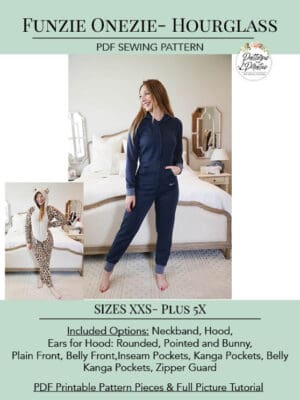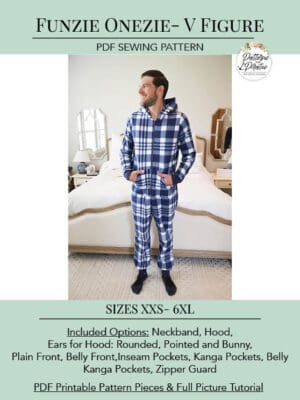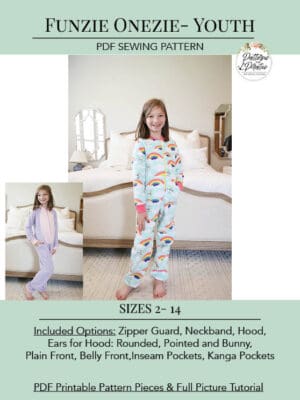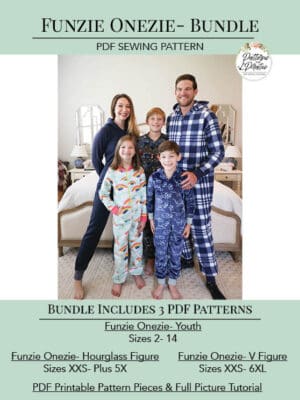We get a lot of questions about Full Bust Adjustments. Since I draft for a true hourglass, curvy figure lots of our ladies have bigger busts. So here is a quick and easy method for knit tops if you need a FBA.
Do you need a FBA?
I see a FBA suggested A LOT in sewing groups, even though it’s not always the problem/solution for ladies (Especially for a P4P pattern that already drafts for a bigger bust.)
So, how do you know? I began putting both upper/over bust and full bust in my measurement charts to help! (Need a refresher on these measurement terms? Here is our How to Measure Yourself post explaining them.)
If your upper bust is a size smaller than your full bust- you need a FBA. If you don’t have those measurements on your pattern then you will have a neckline and shoulder fitting too large when choosing your size from your full bust measurement.
I do NOT advise “choosing your size based on your upper bust measurement” and doing a FBA for that many inches. Indie patterns like mine are much more “true to size” than traditional paper patterns that tend to have a lot more ease built into them. With traditional paper patterns it is often very easy to size down 1-2 sizes on them and still have enough wearing ease. Most indie patterns are not drafted with that much extra ease. I draft my patterns right from that measurement chart meaning if I picked my size based on my upper bust (34.5) I would choose a size small, but I don’t need a small! Both my upper and full bust fit into a medium on the full size chart. I do not need a small with a FBA becuase my frame/upper body isn’t a small. It’s a medium 🙂 This is why I began adding the upper bust measurement into my patterns, to take out that guess work when I saw this recommendation quite a lot. And while it might work well for those traditional paper patterns with more ease- I do not suggest using this method for P4P patterns-or most indie patterns in general.
Here is my size chart with both upper/over bust and full bust.
Got some wrinkles on the full bust area? A FBA is NOT always the answer 🙂 There are a lot of other reasons you might have some wrinkling there!
Both raglan and dolman style sleeves will naturally have some wrinkling there. No matter who that pattern designer is, who is wearing it, fabric choice, or even gender wearing it! The drafting of these two sleeves lay flat when arms are out, which means when arms are down it naturally creates some wrinkling in the armpit area. No biggie 😉
Length is the armsyce is another reason one might have some gaping or pulling. If you are shorter or taller then the height the pattern is drafted for (P4P drafts for average 5’5″), or if you happen to have a different proportion there. You might need to adjust the length of your pattern from the top of shoulder to the armpit rather than needing a FBA. This is difficult to tell just from a picture. It is however much easier in person to see. If you’re not sure try pinching at the shoulder seam to take out some length if you think it might be too long. If it is too short you will feel like the entire shoulder area is too tight and that armpit seam will be up touching your armpit too tightly. For both it is easy to see if you try on the shirt prior to putting the sleeves in. If it is a tank, remember the bands will pull the armysce in though.
Here my lovely tester and model has a little wrinkling because she is a bit shorter than the drafted height. She would benefit from taking just a touch of length from the armsyce.
Here my lovely tester would benefit from the opposite, a bit more length in the armsyce.
You might have some issues with fit through the armsyce and bust if you are wide chested/through the upper back. You would find your upper bust measurement in a bigger size than your full bust. You would need a Small Bust Adjustment (follow the same method just pivoting and tracing to the smaller full bust size).
Here is a gorgeous tester of mine who has begun to trace off a size larger through the neckline and shoulders and adjust down to her smaller bust. This is prior to doing so. You can see it is a bit tight across her shoulders and upper chest area. but fits well in her full bust.
The last reason you might be having fit issues through the bust is not using the appropriate fabric for the top. If your pattern suggest 50% and you sew up a cotton jersey with only 20% you might have pulling at the chest. The opposite problem would be using a very stretchy fabric like a lightweight rayon spandex with a lot of horizontal and vertical stretch making the armsyce droop lower or even gape.
Here I am in the exact same size, but the feathers are a more stable cotton jersey with very little stretch and the grey is a rayon spandex with a ton of stretch and drape. The armsyce is an 1-1.5″ lower in the drapey, stretchy rayon spandex.
One more thing I see sometimes is the drag lines from bust to waist. This is something you will get naturally with an hourglass figure. You have a large difference from your full bust to waist. If your shirt/dress is semi-fitted then you will see those drags pulling into that smaller measurement at the waist. This isn’t asking for a FBA, it’s asking for a dart 🙂 But, most knit shirts don’t have darts, just curves along the side seams. You can’t get as drastic of a change from full bust to waist without a dart. But that’s okay! It’s the nature of a semi-fitted knit top. It doesn’t mean it is ill-fitting. Here are some pictures showing those drag lines, but I have room for my bust and the armsyces are fitting perfectly for my frame. My side seams aren’t pulling drastically to the front of my body on my bustline and it isn’t too tight across my back at the bustline. I don’t need a FBA for my patterns (yay! I do need them on patterns drafted for a more rectangular figure like traditional paper patterns! Just one reason why I love drafting for a curvy figure).
Okay, now if you’re still with me 😉 and you need a FBA here is my favorite, quick and easy method for a knit top. This only adds a bit of width right at the bust. It doesn’t add length. For most women and most knit tops this is sufficient. If you have 2 sizes difference in your upper and full bust you might also add some length to the front center at the bust line and ease it back into the side seam (making the front center curve down). To give your bust some extra length as well.
Here is one of my favorite testers. She has a smaller size upper bust than full bust. Here she did not do a FBA. You can see she has a bit of pulling pointed right to the apex of her full bust. She is your classic case of needing a FBA 🙂 Her side seam will be pulling towards the front of her body instead of laying more evenly along her side.
Here is the “Pivot and Slide FBA Method”:
Step 1: Choose your sizes based off the measurement chart.
Step 2: Pivot
Step 3: Trace
Step 4: Slide back
Now you have a new armsyce that goes wider at the bust, but the same smaller neckline/shoulder fit as the smaller size.
I hope this helps those out there needing this fit adjustment! Once you’ve got it down it really is a very quick and easy method to adding a bit more room for the ladies 🙂





























Thank you for the clear drawings of how to do this. I have a question: does the change at the armscye mean I would then need to use the larger size sleeve pieces? How does that part work?
Thanks in advance for your help. I’m actually trying to get shoulders to be one size and all the rest to be the size larger, which seems like a small adjustment, but I just need that much more room across the bust only. If that’s the case, can I skip the adjustment on the back piece, or do I need it to be the larger size too, in order for the armscyes to match up?
Thank you!
You will pivot the sleeve piece to the larger size as well. If the sleeve is on the fold (like most knit sleeves are) then you will need to do it on the back as well to make it easier on the sleeve pivot 🙂
Hello!
Thank you for such a great post!
I need a little bit more help with how to pivot the sleeve. I pivoted the sleeve from a XXS at the shoulder (the sleeve was on the fold, so from the top of the sleeve), to an XS at the underarm, only now the curve looks a lot flatter. I cut out one sleeve and eased it to the armscye, but it looks almost a bit small. Is that still correct?
Thank you!
Tsalia
You’ll just want to trace out that bottom section not the whole top curve. I hope that helps!
I think I got it! Thank you for your very fast reply. I’m going to give it a try and see how it goes.
Tsalia
You have great instructions for full bust adjustments, but I personally would need a small bust adjustment since you indicate that your patterns are already drafted for a larger bust. Can you please give precise instructions for this adjustment as well?
You would only pivot into a smaller size rather than pivot out to a larger size. Otherwise, it is the exact same method.
After reading over the instructions again, this does make sense to me, thank you!
How do you do this if you are already measuring at the smallest size and still need to do the small bust adjustment?
I would just slide the same difference from the next size up… so if you’re starting at an xxs… I would measure the difference between the xxs and xs (lets say it’s 1/2″) and then pivot from the xxs 1/2″ smaller.
It took me a while to get it but once I did it makes sense. I wish there was a video to go with it!
Thanks for this info, I have a terrible time with tank tops and dresses gaping at the arm holes. Based on your instructions I think I need a SBA. I’m making a color-blocked Sweetheart dress at the moment, would I do the pivot just for the top part? And then what size should the bottom half of the bodice be? the one I started with or the one I pivot to? Many thanks for your help!
I would use your under bust and waist measurement to choose what size the bottom part of the bodice is. Match those measurements to the size chart to that area.